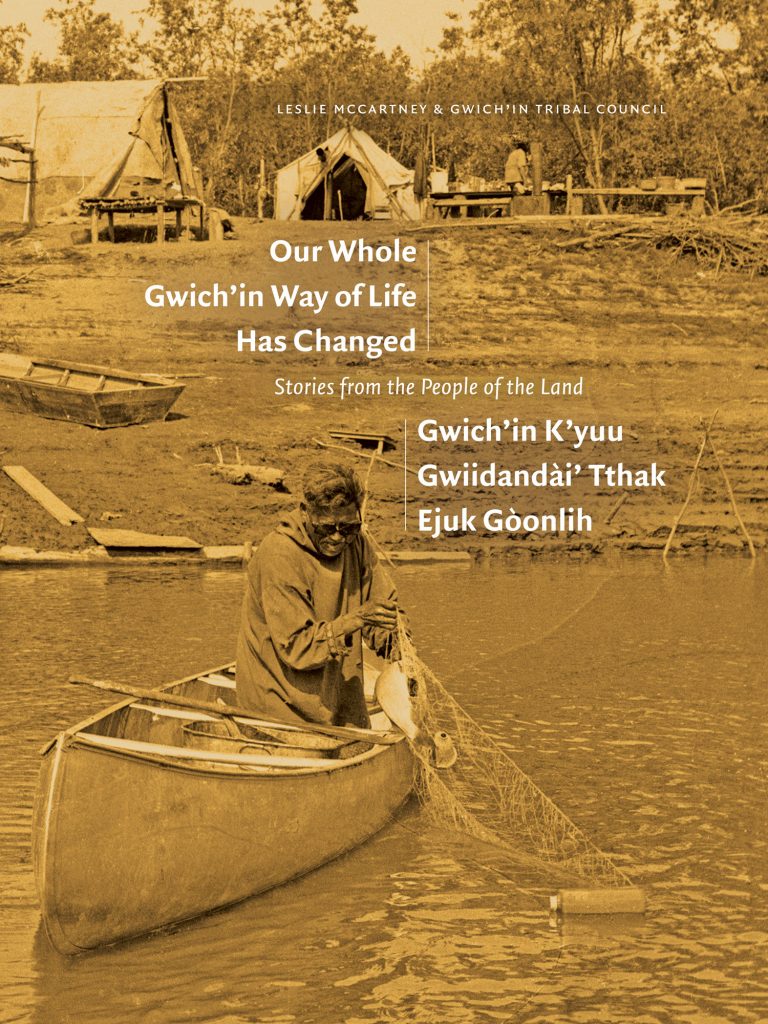A photograph by James Jerome appears on the cover of our newest book, Our Whole Gwich’in Way of Life Has Changed / Gwich’in K’yuu Gwiidandài’ Tthak Ejuk Gòonlih: Stories from the People of the Land. For this post, we invited the book’s co-author Leslie McCartney to tell us about Jerome, his work and importance, and the history of this particular photograph.
Jerome was born on July 31, 1949 in Aklavik. His father was Joe Bernard, a Special Constable with the Royal Canada Mounted Police. Joe was also a trapper and chief of the Gwichya Gwich’in of Arctic Red River (Tsiigehtshik). His mother was Celina (Coyen) Jerome. Pierre Benoit, the man in the canoe, was Celina’s brother and James’s uncle.
James was the youngest of four brothers and two half-sisters. James grew up on the east channel of the Mackenzie River at a camp known as Big Rock (Nichìitsìi Diniinlee).[1]
After spending years on the land with his parents, James attended Grollier Hall residential school in Inuvik. His mother gave him his first camera when he was twelve years old. Unfortunately, both of his parents died before he completed high school. After graduation, he trained to be a welder and, after he received his certificate, he traveled across Canada. Eventually he came back to the north, where he began to pursue artistic endeavours.
Upon returning to the Mackenzie Delta, James travelled the land and photographed families at their fish camps. While doing this, he became concerned that Gwich’in culture would disappear when the Elders died.
In 1977, he began working for Native Press newspaper as a freelance photographer which included remote area work, studio, and aerial photography. At the time of his death, he was working on a book about Dene Elders of the Mackenzie Valley entitled Portraits and History of the Dene Elders of the NWT, which was to include his photographs and stories recounted to him by the Elders. Tragically, James Jerome died in a house fire in Inuvik on November 17, 1979.
The NWT Archives James Jerome fonds consists of approximately 9,000 black and white negatives, four colour negatives, and a small number of black and white and colour print photographs taken by James Jerome in the 1960s and 1970s. The majority of the photographs date from the period 1977-1979. Many were taken in the Fort McPherson and Peel River region, and document life on the land, fur trapping, winter and summer camps, fishing camps, and fish preparation and drying activities of the Gwich’in. In addition there are many portraits, a selection of self-portraits, family photographs, and transportation and recreation photographs. Many of the photographs/negatives are scarred from the fire that took Jerome’s life. The fond also includes textual material such as correspondence and a project description of Jerome’s proposed Portraits and History of the Dene Elders of the NWT‘ publication as well as handwritten and typewritten notes on the project.
The authors are grateful to the NWT Archives for granting permission to use these photographs in this publication.
[1] Nichìitsìi Diniinlee is known as Big Rock in English. The place name refers to three massive rocks which are in the East Channel of the Mackenzie River at this location. This place was one of the main summer gathering places and fish camps for the Gwichya Gwich’in with about ten families living there. (ID 1359; https://atlas.gwichin.ca/index.html#eyJ0IjoieCIsImkiOiJnd2ljaGluLnBsYWNlbmFtZS4xMzU5IiwicyI6MTU0MzA5ODg4MTQ1N30=).

